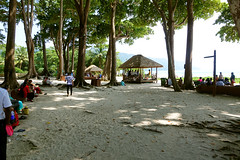Straddling the Beas River as it emerges out of the confines of the Himalayas, the Pong Lake lay limitlessly spread in Kangra district of Himachal Pradesh marking the state border with Punjab. Early this winter season in December 2015, I travelled to this – one of the most popular – winter migratory birdwatching destinations of north India. Starting from Chandigarh and taking pretty country roads through Punjab, I approached the lake from Talwara side. As one drives through the barrage, a wide-ranging view of the vast lake emerges. From here, the north-end of the lake is partially blocked by its prized island curiously called Rancer. Far in the distance, the snow-capped Dhauladhars announce their presence through a faint profile.

Morning at Pong flats; a skein of Bar-headed Geese. Please visit Flickr for more images of the region

Over the years, the Pong wetland has become the largest single congregation destination for Bar-headed Geese not only in India but also in the world. More images from the region at Flickr
Just next to the check post of the barrage, after the state fisheries department office lays the water sports and training facility run by the adventure institute ABVIMAS. I had my accommodation reserved at the state forest department rest house at Nagrota Surian, a sleepy village situated at the north-end of the lake, popular for its birding flats and trails. Driving at a leisurely pace, it took me almost two hours to cover the distance between the barrage and Nagrota Surian via Dhameta and Jawali. The Pong flats must hardly be four “vehicle-able” kilometre from the rest house.

Bar-headed Goose, a hardy bird that has been observed flying over Everest. More at Flickr

A Woolly-necked Stork; also called Bishop Stork or White-necked Stork. More at Flickr

A Little Ringed Plover. Please visit Flickr Photoset for more images of the region

A Kentish Plover; It is smaller, paler, longer-legged and thinner-billed than Ringed Plover. More at Flickr

A River Tern; this guy feeds by plunge-diving for fish or aquatic insects in rivers or lakes. Its numbers are decreasing due to the pollution of their habitat. More images from the region at Flickr

A Pallas’s Gull; This species breeds in marshes of southern Russia to Mongolia. More images at Flickr

A Caspian Gull; This bird breeds around the Black and Caspian Seas extending across Central Asia to north-west China. Please visit Flickr Photoset for more images of the region.

A Black Kite. More images at Flickr
Insofar as birding is concerned, for the next one week or so, I’d get up early morning to reach the Pong flats before fishermen would. Having spent some good bird-full hours by the shoreline of the lake, I’d head back to the rest house for breakfast only to return to the shoreline by early evening. The route would take me through the bustling market and residential colonies of Nagrota Surian, an erstwhile trading base of Kangra region. The scenic prettiness of the landscape climaxes towards evening; with the vast stretches of the lake against the backdrop of setting sun on one side and snowy outposts of the Dhauladhar Range glittering in the evening light on the other.
As the waters of the trans-Himalayan region along with wetlands of Europe, North and Central Asia gets frozen every winters, flocks of waterfowls that breed in those areas in summers migrate to plains located south of the Himalayas. Also called Maharana Pratap Sagar, this vast reservoir that was primarily constructed in 1974 as a check dam to store water for irrigation as well as to generate power, is thronged by no less than 1,50,000 avian visitors on average (2010 two-day bird count). The emerging wetlands gathered international eyeballs after it was declared a Ramsar Site in 2002. Every winter, the shoreline of the lake could be seen abuzz with flapping wings and cackling sounds of varieties of waterfowls including Bar-headed Geese, lake’s most regular date. The stagnant fresh water adds to the concentration of organic matter, worms, insects or molluscs and other tiny creatures that make this wetland most popular among winged visitors particularly Bar-headed Geese whose visiting population at the lake constitute more than 40 per cent of its population in the world. Not only this but rare species like Indian Skimmer, Whooper Swan, Red-necked Grebes, White-fronted Geese along with many others of vultures, falcons and waders, etcetera have been recorded.

A faint profile of Rancer island from the shoreline. More from the region at Flickr Photoset

View from the Meenu Khad at sundown. More images from the region at Flickr Photoset
With winters setting in, the receding shoreline of the lake near the villages of Jawali, Dhameta, Dada-Siba, Haripur, Guglara, Harsar, and Nandpur as also of Nagrota-Surian provide ample opportunities to a birdwatcher. Full of life, the nutrient-rich mudflats along the shore-line attract birds such as lapwings, waders, egrets and herons, etc. even as the open waters prove to be a heaven for ducks, grebes, geese or cormorants. The drier sand banks and waterside vegetation and shrubbery attract curlews, warblers, babblers, munias, kingfishers, moorhens and predators, etc.
Back at the rest house, the caretaker tells me that when the waters begin to recede, the villagers seasonally farm the land in the periphery of the lake. This along with commercial fishing and the grazing by nomadic herds of cattle is reasonably effective in attracting birds as long as everything is done below a tolerable level. The villagers are increasingly becoming more aware of conservation.

Lakeview from a partially exposed Bangoli Chook. More images from the region at Flickr
Also, just if you thought that Pong’s travel charm is limited to birding, there are a number of places of cultural and mythological importance within the vicinity of the lake. And although I didn’t partake in activities like boating, angling or water sports but the caretaker mentioned that such activities not only require permissions through official channels but some expertise as well. The popular islands of the lake Rancer, Karu, Rajeli, Jattan Da Kuwal, Dhanderh that are good and reclusive for birding, offer equally good prospects for boating.

Magical Pong; possibly one of the best lakeside sunscapes. More images from the region at Flickr
The official checklist of the Pong mentions close to 415 species of birds in addition to many animals, reptiles and fishes. Here is a list of birds I saw at Pong: Northern Lapwing (a lifer for me!), Bar headed Geese, Ruddy Shelduck, Sarus Crane, Coots, Wagtails, Pied-Kingfisher, Black Kite, Brown Headed Gull, River Terns, Purple Swamphen, Eurasian Wigeon, Northern Shoveler, Cormorants, Greater Coucal, White-breasted Waterhen, Little Grebe, Northern Pintail, Common Pochard, Gadwall, Spot-billed Duck, Common Teal, Bank Mynas, House Crows, Pipits, Larks, Sandpiper, Cattle Egret, Snipe, Red-wattled Lapwing, Little Egret, Great Egret, Black Kite, Black-shoulder Kite and plus some Herons.

Nomadics! :-). Please visit Flickr Photoset for more images of the region
 bNomadic
bNomadic













I am in love with this place and have participated in bird counting drive 2 years back. Thanks for such a brilliant post.
Thanks for stopping by Sharma Ji. Truly a beautiful place for birdwatching. Keep visiting bNomadic for more such travel stories 🙂
Any specific name of the scantury?
Pong Dam bird sanctuary or Maharana Pratap Sagar. Its a Ramsar site.
Thankyou
bNomadic I Love bids… and i love this post extremely…
Pingback: Lost Temples and Castles of Kangra Foothills | bNomadic
Been ages since I did some serious bird watching of any kind :D. Loved this.
Not only for bird watching, the Pong is a good place to relax and unwind provided you visit at a right time of the winter season. Keep visiting bNomadic 🙂
Nice post. I have gone to Kumarakom Bird Sanctuary in Kerala and could not locate a single bird.
I wonder how you managed to capture so many!
Thanks for stopping by the blog Neha! Kumarakom is a beautiful place to spot and watch birds. Keep visiting bNomadic for more such travel and wildlife stories 🙂